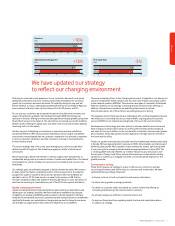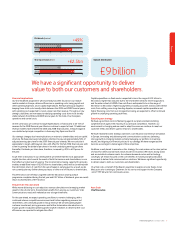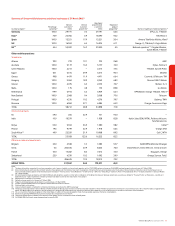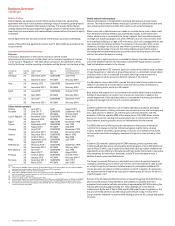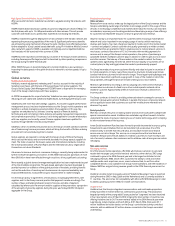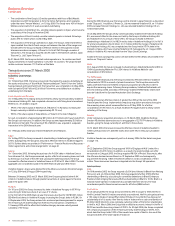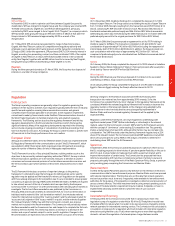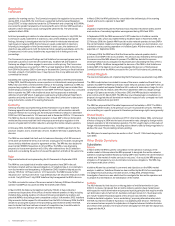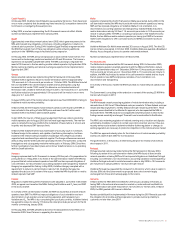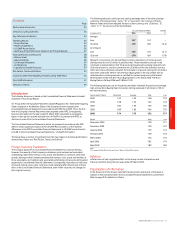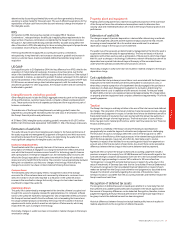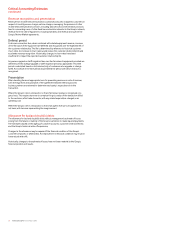Vodafone 2006 Annual Report Download - page 21
Download and view the complete annual report
Please find page 21 of the 2006 Vodafone annual report below. You can navigate through the pages in the report by either clicking on the pages listed below, or by using the keyword search tool below to find specific information within the annual report.
Vodafone Group Plc Annual Report 2006 19
exclusive Vodafone branded handsets, will drive incremental revenue benefits, as well
as cost savings, through reduced churn and higher ARPU per handset.
•Finally, the focus of the roaming initiative is to transform customers’ roaming
experience, primarily through reducing barriers to usage by providing better value
when they travel abroad. In addition, providing the best value inter-operator tariffs and
consolidating certain roaming support activities are key goals of the programme.
Vodafone Passport has been launched in 13 markets and over 6 million customers
have signed up to the service at 31 March 2006. Improvements in customer
satisfaction and a higher proportion of customers roaming on to Vodafone networks
have been observed.
Research and Development (“R&D”)
The Group’s R&D function comprises an international and multicultural team for applied
research in mobile telecommunications and its applications. The majority of the Group’s
R&D function is undertaken through the Group’s centres of excellence, located in
Newbury, Maastricht, Munich, California, Milan and Madrid, and in an associate centre in
Paris belonging to Vodafone’s associated undertaking in France, SFR. In the 2006
financial year, the R&D Centre in Tokyo was re-absorbed into the Japanese operation and
ceased to engage in research and development for the Vodafone Group. The work of the
centre in California was refocused to activities where a presence in the US was essential
in order to carry them out and the size of the centre reduced accordingly. Early in 2006,
the Group’s R&D function was given full responsibility for intellectual property across the
Vodafone Group.
The Group’s R&D function provides technical leadership, and a programme of research
support, into technology that will typically start to be used in the business in three years
and beyond. Governance is provided by the Group R&D Board which is chaired by the
Group R&D Director and consists of the chief technology officers from four of the mobile
operating subsidiaries, together with the heads of Future Products, Business Strategy,
Terminals and Technology Development.
The Group’s R&D function focuses on applied research that is positioned between the
basic research undertaken by universities and commercial product development. The
emphasis of the Group’s R&D work programme is on providing technology analysis and
vision that can contribute directly to business decisions, enabling new applications of
mobile telecommunications, using new technology for new services, and research for
improving operational efficiency and quality of the Group’s networks. The work
programme is organised into technology research and application research. The
technology research is concerned with core radio, network and service enabling
technologies. It includes business modelling techniques, application of social science
and analysis of disruptive technologies. The application research is concerned with
developing new business applications of radio based technologies for commercial
launch. Both areas of research are directed to expanding business boundaries and
opportunities through advances in technology, science and business practice.
The work of the Group’s R&D function is delivered through a series of programmes with a
substantial number of trials, demonstrations and protoypes. All work is set in a business
and social context. There is growing emphasis on work that secures intellectual property
rights or can otherwise lead to Vodafone having stronger influence on the technology it
will deploy in the future. In addition, the Group’s R&D function provides leadership for
funding research into health and safety aspects of mobile telecommunications and
technical leadership for the Group’s spectrum strategy.
The main themes currently being researched are the evolution of 3G, new application
areas for mobile communications and convergence with the internet. The basis of the
Group’s 3G radio technology is W-CDMA and enhancements to provide a higher speed
version, usually referred to as HSDPA, or High-Speed Uplink Packet Access (“HSUPA”), are
currently being rolled out. The focus over the last year has been on setting scientifically
justifiable targets for the long term evolution of the 3G radio interface and establishing
these within the industry. Evolutions to the core network based on ubiquitous use of
internet protocols and web services complement this, and are leading to a convergence
of internet and mobile technologies. Several internet based or converged services have
been prototyped and demonstrated within the Vodafone community. Significant R&D
effort has also been dedicated to transferring previous research results in mobile TV to
the Group’s marketing and technology functions to provide the basis for the Vodafone’s
mobile TV programme. Applications of mobile telecommunications to health and well
being, intelligent transport systems and the digital home are also being researched.
Much of the work of the Group’s R&D function is done in collaboration with others, both
within the Group and externally. Joint R&D facilities have been set up with three major
infrastructure suppliers. Infrastructure and handset suppliers work with the Group’s R&D
function on many of its projects, from providing equipment for trials, through co-
authoring research reports, to being a partner in some of the R&D programmes. At the
more academic end of the spectrum of applied research, the Group’s R&D function
continues to develop relationships with a number of universities. These relationships
include sponsoring research students, collaboration in European research activities,
funding specialised research centres and working with Vodafone funded chairs and
readerships. This year, the Group’s R&D function hosted an Academic Conference where
it brought together its academic partners to consolidate its academic research
programme.
The R&D programme provides the Group with long term technical policy, strategy and
leadership, as well as providing technical underpinning for the Group’s public policies
and government relations, and is shared with all of the Group’s mobile operations and
common functions. They are able to influence the programme through working
relationships that are designed to allow delivery of the results of the programme directly
into the business units where they are needed.
The Group expensed £206 million in the 2006 financial year on R&D, compared with
£198 million in the 2005 financial year, and capitalised development costs of £10
million (2005: nil). Besides the core R&D outlined above, this expenditure was incurred
principally on developing new products and services, billing systems and network
development.
Non-mobile Telecommunications
The Group’s non-mobile telecommunications businesses comprise interests in Arcor,
Neuf Cegetel and Bharti Airtel (“Bharti”), previously named Bharti Tele-Ventures.
Arcor is the second largest fixed line telecommunications provider in Germany. Based on
its own Germany-wide voice and data network, Arcor offers its customers a range of
services for voice and data transfer, with a focus on direct access based broadband and
internet protocol enabled virtual private network (“IP-VPN”) products. The Group’s
ownership interest in Arcor is 73.7% and it is accounted for as a subsidiary.
The merger of Cegetel and Neuf Telecom completed on 22 August 2005, creating the
leading alternative operator for fixed telecommunication services in France, offering a
wide range of fixed line telephone services to residential and business customers as well
as special corporate services ranging from internet and customer relations management
to internet and intranet hosting services. The new entity, Neuf Cegetel, has the largest
alternative broadband network in France, with 70% population coverage. The Group’s
indirect ownership interest in Neuf Cegetel is 12.4% and it is accounted for as an
associated undertaking. In May 2006, the Group’s indirect ownership interest increased
to 15.4%.
Bharti is an Indian based mobile fixed line telecommunications operation with three
strategic business units: mobility, enterprise services and broadband. The Group’s
ownership interest in Bharti is 10% and it is accounted for as a joint venture.
History and Development of the Company
The Company was incorporated under English law on 17 July 1984 as Racal Strategic
Radio Limited (registered number 1833679), as a subsidiary of Racal Electronics Plc, and
changed its name to Racal Telecommunications Group Limited in September 1985. In
September 1988, it became Racal Telecom Limited then re-registered as Racal Telecom
Plc, a public limited company. In October 1988, approximately 20% of the Company’s
capital was offered to the public. The Company was fully demerged from Racal
Electronics Plc and became an independent company in September 1991, at which time
it changed its name to Vodafone Group Plc.
Between 1991 and 1999, the Group consolidated its position in the United Kingdom and
enhanced its international interests through a series of transactions. At 31 March 1999,
the Group had subsidiary mobile network operating companies (“mobile operating
subsidiaries”) in six countries (the UK, the Netherlands, Greece, Malta, Australia and New
Zealand), as well as equity interests in a further seven countries, and a proportionate
mobile customer base of 10.4 million.
The Group completed a number of business transactions between 1999 and 31 March
2003, which transformed the Company into the world’s leading international mobile
telecommunications company. The most significant transactions were:
•The merger with AirTouch Communications, Inc. (“AirTouch”), which completed on
30 June 1999. The Company changed its name to Vodafone AirTouch Plc in June
1999. The combined Group had mobile operating subsidiaries in 10 countries,
(adding Sweden, Portugal, Egypt and the US) and equity interests in an additional
12 countries.
•The acquisition of Mannesmann AG (“Mannesmann”), which completed on 12 April
2000. Through this transaction the Group acquired subsidiaries in two of Europe’s
most important markets, Germany and Italy, and increased the Group’s indirect
holding in SFR, a French mobile telecommunications operator. Subsequent to the
acquisition, the Group sold a number of non-core businesses acquired as part of the
Mannesmann transaction. Following approval by its shareholders at the Annual
General Meeting (“AGM”), the Company reverted to its former name, Vodafone Group
Plc, on 28 July 2000.
Business


